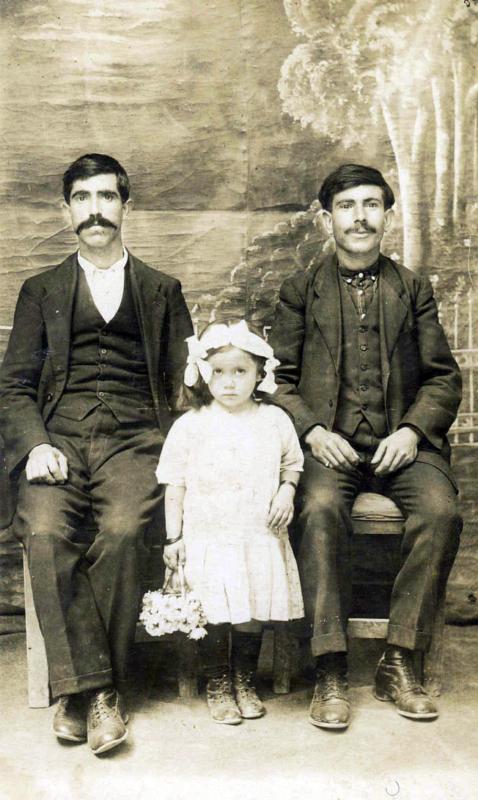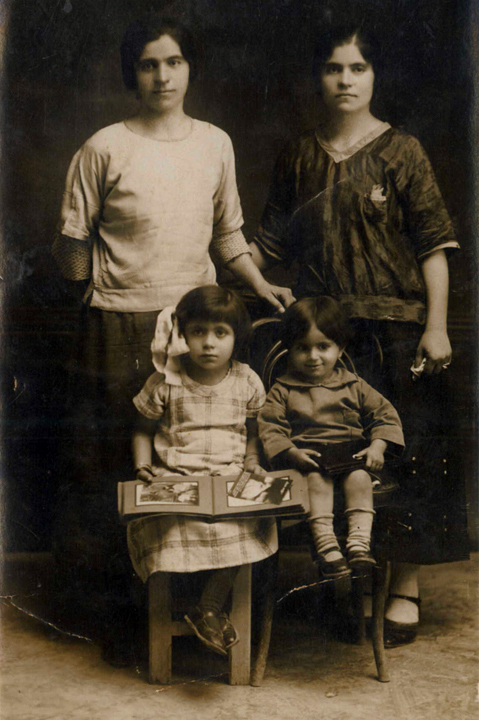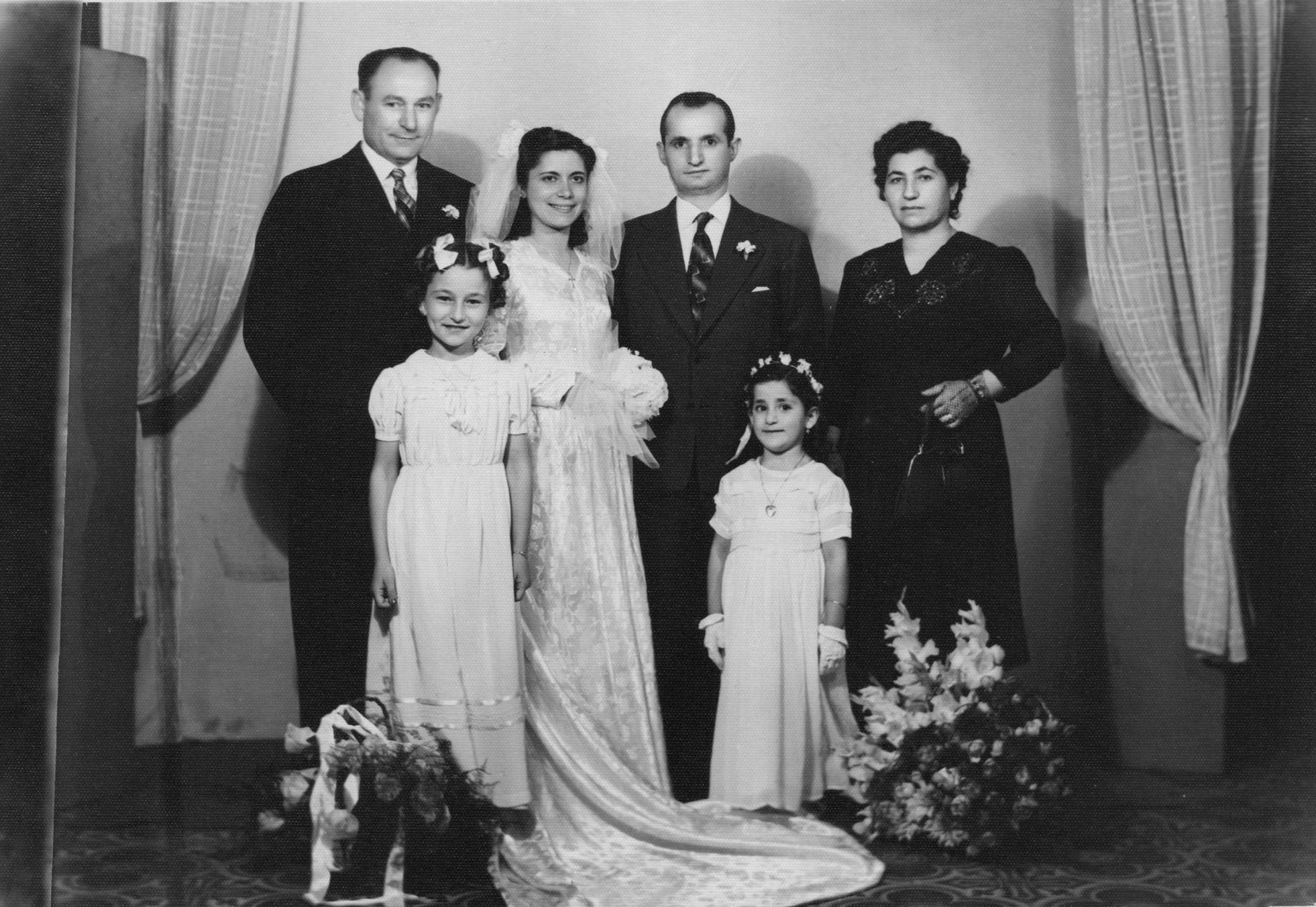 |
 |
 |
 |
| Assanna with father Avedis |
Guiragos is the boy with hat at the top left |
Oghida and Jale with little children |
Wedding photo of Assanna and Guiragos |
Our
grandfather Guiragos Demirdjian was a survivor of the Armenian
Genocide, his mother Heripsime Dedeyan and his father Harutyun
Demirdjian, both of unwavering Christian faith.
Guiragos
was born on September 27, 1908 in Yozgat,
today a land usurped by Turkey. Our grandfather remembered that at
the age of 5 years "sitting on his grandfather's knees, he felt
his face get wet without knowing why, years later he would realize
that they were his grandfather's tears, which wet him as he ran
through his long white beard. It was that night that he saw his
family killed before his eyes.” Only our grandfather with 3 of his
brothers and some of his nephews managed to escape. Days later they
were caught and deported to the desert of Aleppo, Syria. Besides
surviving death, our grandfather had to survive the caravan, in harsh
conditions, in which he encounters horror again, one night his little
brother who was sleeping in the tent next to him was robbed. That
tortured him forever, that's how he and his nephews and his sister
tried to stay together all their lives.
In
Syria he lived in an Italian orphanage, he learned to cook, then he
is sheltered by an Arab family, who gave him a home, but he wouldn’t
not stay there, he would help his nephews Aram, Baitzar, Ieghish and
his sister Gussuma to travel to America in search of a new life.
Guiragos
recalled that, in that context of despair, in the midst of horror,
the churches were a shelter and that the priests told everyone that
America was a destination where they would find peace. At the age of
23, Guiragos embarked in the port of Cherbourg on a British-flagged
ship called ALCANTARA, on August 2, 1929 he left the Port of
Southampton and arrived at the port of Argentina on August 20, 1929,
with his memories, following his nephews, and his sister Gussuma
Demirdjian de Kasparian being reborn.
LONGING
TO RETURN TO ARMENIA ONE DAY
In
South America, in Argentina, he meets Assanna Sarkissian, another
survivor of the Genocide; they get married and have 3 children. Our
grandmother Assana was the last survivor of the genocide in the city
of Rosario, she was born in 1921, in Armenia, in the province of
Diaberkir.
Assana’s mother, Oghida Ohannessian saw her mom beaten to death by
Turkish gangs.
Assana
did not have grandparents, she says that her parents Avedis, Oghida
and Jale, her mother's older sister with her two children, hid in a
basement, weeks later the children died of starvation.
Fleeing
death, for "being Armenians", they arrive in Aleppo -
Syria, and remain in a refugee camp, until the orders to annihilate
the children of the Armenians come from the Turkish Deportation
Committee.
Following
the journey of survival, they flee to Mosul, Iraq, in that city their
brother Garabet is born. They remain for 2 years until they try to
reach Beirut, Lebanon. From there to the port of Marseille, to board
the ship called "Silver", with the French flag. On November
30, 1926 they left for Argentina, arriving on December 23, 1926.
Argentina
would be their Paradise;
this is how they expressed it when they gathered in the house of
their mother Oghida together with other Armenians from the West Zone
of the city of Rosario, remembering what they had left behind in
Armenia, the longing for their homes and their decimated families. A
tribute to them was cooking typical Armenian food, speaking the
Armenian language that was forbidden to them in the Ottoman Turkish
Empire. From that moment Argentina sheltered them and allowed them to
"be Armenian", to maintain their identity without being
persecuted.
My
grandparents had 3 children, 10 grandchildren and 11
great-grandchildren, my sisters and I inspired by their lives, since
1994 we have established a space for study, research and teaching on
Armenia and the Armenian Question at the National University of
Rosario, remaining institutionalized in the UNR Armenian Free Chair
and the Center for Armenian Studies. Memory, commitment, and
solidarity are part of our education, and we believe that the task of
raising awareness and visibility helps to prevent other genocides to
a large extent to heal the wounds and honor the victims.
Florencia
Demirdjian